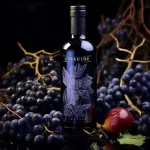Wine has played a significant role in literature for centuries, from ancient times to the modern era. In this article, we will explore how wine has been used as a symbol, theme, and metaphor in various works of literature, and how it reflects the cultural and social values of different societies.
Introduction
Wine has been an integral part of human culture for over 6000 years, and its significance in literature has been no less profound. Throughout history, wine has been depicted in literature as a symbol of wealth, luxury, pleasure, and communion. It has been used to express different emotions, such as love, joy, sorrow, and despair, and to signify different values, such as hospitality, generosity, and conviviality. Wine has also been employed as a metaphor for life, death, and the human condition.
The Symbolism of Wine in Literature
In literature, wine has often been used as a symbol of wealth, power, and luxury. In ancient Greek literature, wine was associated with the god Dionysus, who was the patron of wine, theater, and ecstasy. The Greek playwrights often used wine as a symbol of excess, disorder, and irrationality, as well as of spiritual transcendence and divine inspiration.
In medieval literature, wine was often depicted as a symbol of Christian sacrament and redemption. The Holy Grail, which was the cup used by Jesus Christ at the Last Supper, was often associated with wine, and was said to possess miraculous powers. Wine was also used to symbolize the blood of Christ, which was shed for the salvation of humanity.
In Renaissance literature, wine became a symbol of the Italian and French aristocracy, who were known for their lavish banquets and wine-tasting parties. Wine was also used to symbolize the pleasures of life, such as love, music, and poetry. William Shakespeare often used wine as a symbol of love, seduction, and betrayal, as well as of the transience of life.
Wine as a Theme in Literature
Wine has also been used as a central theme in literature, where it serves as a catalyst for action and character development. In Ernest Hemingway’s “The Sun Also Rises,” wine is a constant presence, representing the hedonistic lifestyle of the Lost Generation, and the emptiness and disillusionment of post-World War I Europe. The characters in the novel drink excessively, hoping to escape their pain and frustration, but ultimately, they find no redemption in alcohol.
In F. Scott Fitzgerald’s “The Great Gatsby,” wine is a symbol of the excesses of the Roaring Twenties, and the moral decay of American society. The parties thrown by Jay Gatsby are characterized by the consumption of vast quantities of champagne, which represents the superficiality and artificiality of the Jazz Age. The characters in the novel are consumed by their desire for wealth and status, and they use wine as a means of social climbing and self-indulgence.
Wine as a Metaphor in Literature
Wine has also been used as a metaphor in literature, where it represents the complexities and contradictions of human existence. In John Keats’ “Ode to a Nightingale,” wine is used as a metaphor for poetic inspiration, and the transcendence of the mortal world. The speaker of the poem longs to escape his pain and suffering, and seeks refuge in the beauty and mystery of nature.
In Langston Hughes’ “Harlem,” wine is used as a metaphor for unfulfilled dreams and aspirations. The speaker of the poem asks what happens to a dream deferred, and suggests that it dries up like a raisin in the sun, or festers like a sore, or stinks like rotten meat.
Wine in Different Cultures and Societies
Wine has been an important part of many different cultures and societies throughout history, and its role in literature has reflected these cultural and social values. In ancient China, for example, wine was considered an essential part of the Confucian ritual of hospitality, and was used to reinforce social hierarchies and relationships. In Japanese literature, sake, a type of rice wine, has been used as a symbol of tradition, discipline, and honor, as well as of the transience and impermanence of life.
In Western literature, wine has been associated with various social classes and groups, depending on the historical and cultural context. In the Middle Ages, for example, wine was mostly consumed by the aristocracy and the clergy, and was often associated with religious ritual and sacrament. In the Renaissance, wine became more widely available, and was consumed by the middle class as well as the aristocracy, but was still seen as a luxury item. In the modern era, wine has become more democratized, and is consumed by people of all social backgrounds and classes, but is still associated with refinement and sophistication.
Wine and the Human Experience
Wine has been used in literature to explore various aspects of the human experience, such as love, friendship, loss, and mortality. In Elizabeth Barrett Browning’s “Sonnet XLIII,” wine is used as a metaphor for the speaker’s love for her husband, as well as for her fear of losing him. The speaker says that her love is like a wine that grows richer over time, but also acknowledges the fragility and impermanence of this love.
In Edgar Allan Poe’s “The Cask of Amontillado,” wine is used as a means of revenge, as the protagonist lures his enemy into a wine cellar and buries him alive. The wine in the story represents the intoxicating power of revenge, as well as the madness and darkness of the human psyche.
Conclusion
Wine has played a significant role in literature throughout history, and has been used as a symbol, theme, and metaphor to explore various aspects of the human experience. Its cultural and social significance has been reflected in the way it has been depicted in different works of literature, and has evolved over time as wine has become more widely available and democratized. Wine will likely continue to inspire writers and readers alike, as a powerful symbol of humanity’s joys and sorrows, and a reminder of our mortality.
FAQs
- What is the history of wine in literature?
- Wine has been used in literature for centuries, from ancient times to the modern era, and has been associated with various cultural and social values.
- How has wine been used as a symbol in literature?
- Wine has been used as a symbol of wealth, luxury, pleasure, and communion, as well as of excess, disorder, and irrationality.
- How has wine been used as a metaphor in literature?
- Wine has been used as a metaphor for life, death, and the human condition, as well as for poetic inspiration and the power of revenge.
- What is the cultural significance of wine in literature?
- Wine has been an important part of many different cultures and societies throughout history, and its role in literature has reflected these cultural and social values.
- How has the role of wine in literature evolved over time?
- The role of wine in literature has evolved as wine has become more widely available and democratized, and has been associated with different social classes and groups depending on the historical and cultural context.









